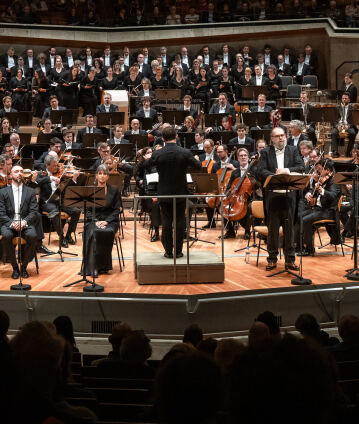Kirill Petrenko conducts Schoenberg

Kirill Petrenko devotes himself to two seminal works of the 20th century. Arnold Schoenberg’s Chamber Symphony No. 1 marks a turning point, away from late Romanticism to a more modern musical language. His unfinished oratorio Jacob’s Ladder also demonstrates the expressive power that developed from this transition. The work is based on Jacob’s dream about the ladder to heaven that leads to God – a parable about the human search for spirituality.
Before turning to atonality in works such as the Three Piano Pieces op. 11 and the String Quartet op. 10, Arnold Schoenberg’s 1906 Chamber Symphony No. 1 op. 9 saw him once again exploit all the possibilities of tonal composition.
His concept of a symphony for small forces was completely new – especially at a time when Gustav Mahler was working on his gigantic Eighth Symphony. It signalled nothing less than a radical rethinking of the genre: towards the compact texture of an interwoven, highly expressive web of voices that demanded the highest degree of chamber music precision.
On the other hand, Schoenberg’s oratorio Die Jakobsleiter (1915–1922), based on his own libretto, is monumental: a philosophical work which, in addition to a huge orchestra, also required vocal soloists and choir plus off-stage choirs and orchestra. The piece has only survived as a draft, with the last 15 bars only as a sketch. A score, which makes performances possible at all, was written by Schoenberg’s long-time pupil Winfried Zillig, who said about the piece: “Strangely enough, the end of the Jakobsleiter fragment is one of the most impressive endings ever to be found in Western music. Schoenberg’s invention of sounds floating in space really does open up new realms. The enchantment is complete, despite the fragmentary nature.”
© 2024 Berlin Phil Media GmbH
Related interviews
Artists
Our recommendations
- Simon Rattle conducts Mahler’s Second Symphony
- Daniel Barenboim conducts Verdi’s Requiem
- A Verdi evening with Christian Thielemann
- Kirill Petrenko with Strauss’s “Die Frau ohne Schatten” in Baden-Baden
- Bach’s “St John Passion” with Simon Rattle and Peter Sellars
- Kirill Petrenko conducts Strauss’s “Elektra” at the Easter Festival in Baden-Baden